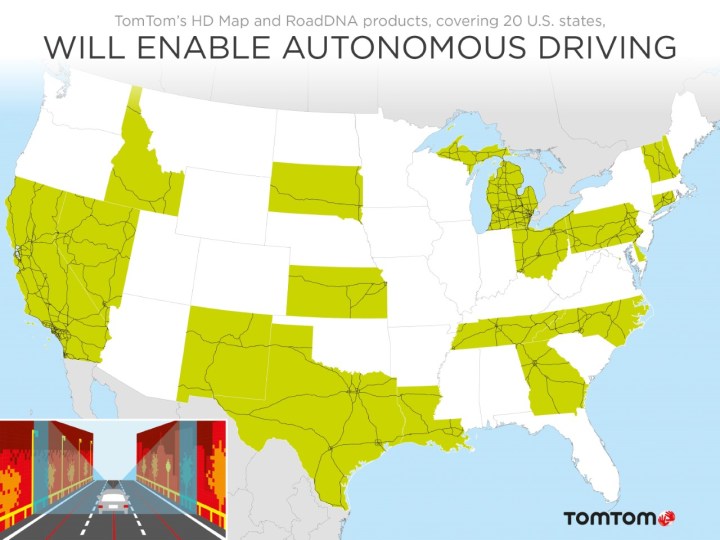
The biggest reveal is that the Dutch brand has officially launched HD Map and RoadDNA data for 17 new states, both of which provide essential information for carmakers developing self-driving technology. In total, TomTom has mapped out 20 states.
“With over 122,000 kilometers of HD Map coverage globally, we’re equipping our automotive customers with the data needed to continue to push autonomous driving forward,” said Willem Strijbosch, head of autonomous driving at TomTom. “The importance of having a map in the vehicle for autonomous driving is now widely accepted; TomTom has responded to this need with an unprecedented ability to provide HD Maps today, while others are still in the R&D stage.”
Read more: TomTom’s Trucker 5000 is specifically suited for big and tall driving
HD Map and RoadDNA data is now available for interstates in the following areas: Connecticut, Delaware, the District of Columbia, Georgia, Idaho, Kansas, Louisiana, New Hampshire, New Mexico, North Carolina, Ohio, Pennsylvania, Rhode Island, South Dakota, Tennessee, Texas, Vermont, California, Michigan, and Nevada. TomTom also covers Germany’s famous Autobahn network.

It wasn’t all about driverless tech at TU-Automotive Detroit though, because TomTom made another big announcement regarding infotainment — the brand has signed a deal to provide location and navigation content for Volvo Cars starting in 2019. The new services will be built into the Swedish automaker’s new infotainment system, which will be available on cars riding on the SPA platform (XC90, S90, V90) as well as the upcoming CMA architecture.
“We are extremely pleased to announce this collaboration between TomTom and Volvo Cars, one of the most respected car brands in the world,” said Antoine Saucier, managing director of TomTom Automotive. “Thanks to the trust that Volvo Cars has put into TomTom’s products, we are uniquely positioned in the automotive industry to offer Volvo Cars future-proof systems that meet the rapidly changing market requirements.”
Editors' Recommendations
- The future of cars: A new spin on an old idea could revolutionize autonomous vehicles
- Huawei taps TomTom to help it navigate to a Google Maps alternative
- Amazon slashes TomTom GPS prices ahead of Cyber Monday
- Setback for GM’s autonomous car unit as it delays launch of robo-taxi service
- Semi-autonomous and always available: A peek into the near future of car rental


